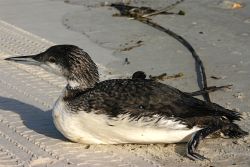 19 November 2007
19 November 2007
Yesterday was gray and drizzly and great for birds at Moraine State Park. I went there to find ducks and tundra swans. Instead I found hundreds of loons.
Over 300 common loons (Gavia immer) on Lake Arthur is an amazing number considering that loons migrate alone or in small groups and are rarely seen in large numbers. In one glance I saw more loons than I’ve seen in my entire life. A loon fallout!
“Fallout” usually means something bad but in birding it’s great. When migrating birds hit bad weather the flocks have to land. So many come down in one place that it seems they fall out of the sky.
So why loons? I can only imagine it happened like this: On Saturday evening fifty or more small flocks of loons each made the individual decision that it was time to leave the Great Lakes for the coast. They all headed southeast for Chesapeake Bay but when they reached western Pennsylvania they found the leading edge of bad weather, fog, and rain. They realized it was only going to worsen so they landed at Lake Arthur.
Loons have few choices on where to land. They are excellent divers but their bodies are heavy and hinged incorrectly for walking. They can only take off from water and even then they need a long runway to get airborne. If they land on anything except a large area of open water, they cannot take off again and will be stranded and die. Lake Arthur was their best and perhaps their only choice.
There were other birds, too. Overlooking the water was Best Bird of the day, a Northern Shrike (Lanius borealis) a rare northern visitor. The only way to improve the outcome would have been to see tundra swans.
p.s. Chuck Tague once found a common loon in winter plumage on a beach in Florida, pictured above. As you can see, the loon’s legs are far back on its body, not good for walking.
(photo by Chuck Tague)